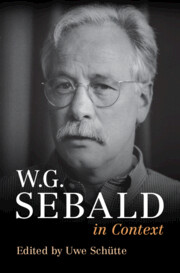Book contents
- W.G. Sebald in Context
- W.G. Sebald in Context
- Copyright page
- Dedication
- Contents
- Illustrations
- Notes on Contributors
- Preface
- Acknowledgements
- Note on Text
- Chronology
- Abbreviations
- Works by W.G. Sebald
- Part I Biographical Aspects
- Part II The Literary Works
- Part III Themes and Influences
- Part IV Reception and Legacy
- Chapter 31 Sebald Scholarship
- Chapter 32 Sebald in Translation
- Chapter 33 The Sebaldian
- Chapter 34 Film
- Chapter 35 Pop Music
- Chapter 36 Literary Prizes
- Chapter 37 Visual Arts and Exhibitions
- Chapter 38 The Cult of Sebald
- Further Reading
- Index
Chapter 32 - Sebald in Translation
from Part IV - Reception and Legacy
Published online by Cambridge University Press: 24 August 2023
- W.G. Sebald in Context
- W.G. Sebald in Context
- Copyright page
- Dedication
- Contents
- Illustrations
- Notes on Contributors
- Preface
- Acknowledgements
- Note on Text
- Chronology
- Abbreviations
- Works by W.G. Sebald
- Part I Biographical Aspects
- Part II The Literary Works
- Part III Themes and Influences
- Part IV Reception and Legacy
- Chapter 31 Sebald Scholarship
- Chapter 32 Sebald in Translation
- Chapter 33 The Sebaldian
- Chapter 34 Film
- Chapter 35 Pop Music
- Chapter 36 Literary Prizes
- Chapter 37 Visual Arts and Exhibitions
- Chapter 38 The Cult of Sebald
- Further Reading
- Index
Summary
This essay introduces key issues relating to the translation of Sebald’s work into English and to his international reception in general. It shows how the reception of Sebald’s work in translation led to his canonization as “Holocaust author”, due in part to the sequence but also due to the tone of the translations. The essay discusses Sebald’s personal interest in translation practices and his heavy involvement in the English translations of his own work. It shows how Sebald might change the meaning in translated versions because of issues he identified with the German originals, and how his interventions and revisions impacted on his collaboration with the translators. In addition to the grammatical complexity of the German language, Sebald’s writing poses specific problems for the translator, such as the inclusion of very long sentences, regionalisms, unacknowledged citations, and a syntax and style partially modelled on nineteenth-century writers. The essay concludes with a discussion of untranslatability concerning Sebald’s use of troublesome vocabulary, such as the Nazi Jargon in Austerlitz or the offensive term ‘Neger’ (‘negro’) in The Emigrants.
Keywords
- Type
- Chapter
- Information
- W. G. Sebald in Context , pp. 287 - 294Publisher: Cambridge University PressPrint publication year: 2023

